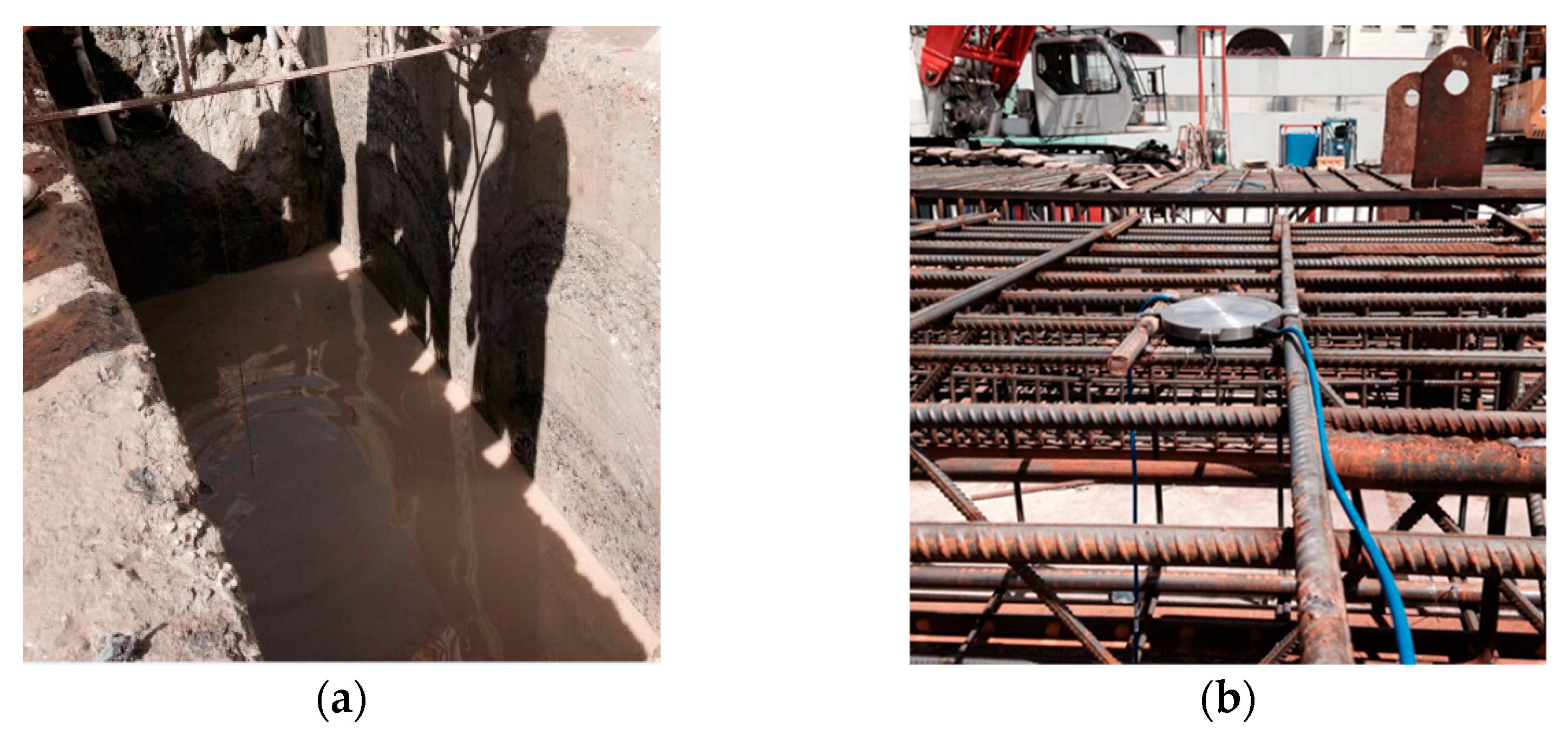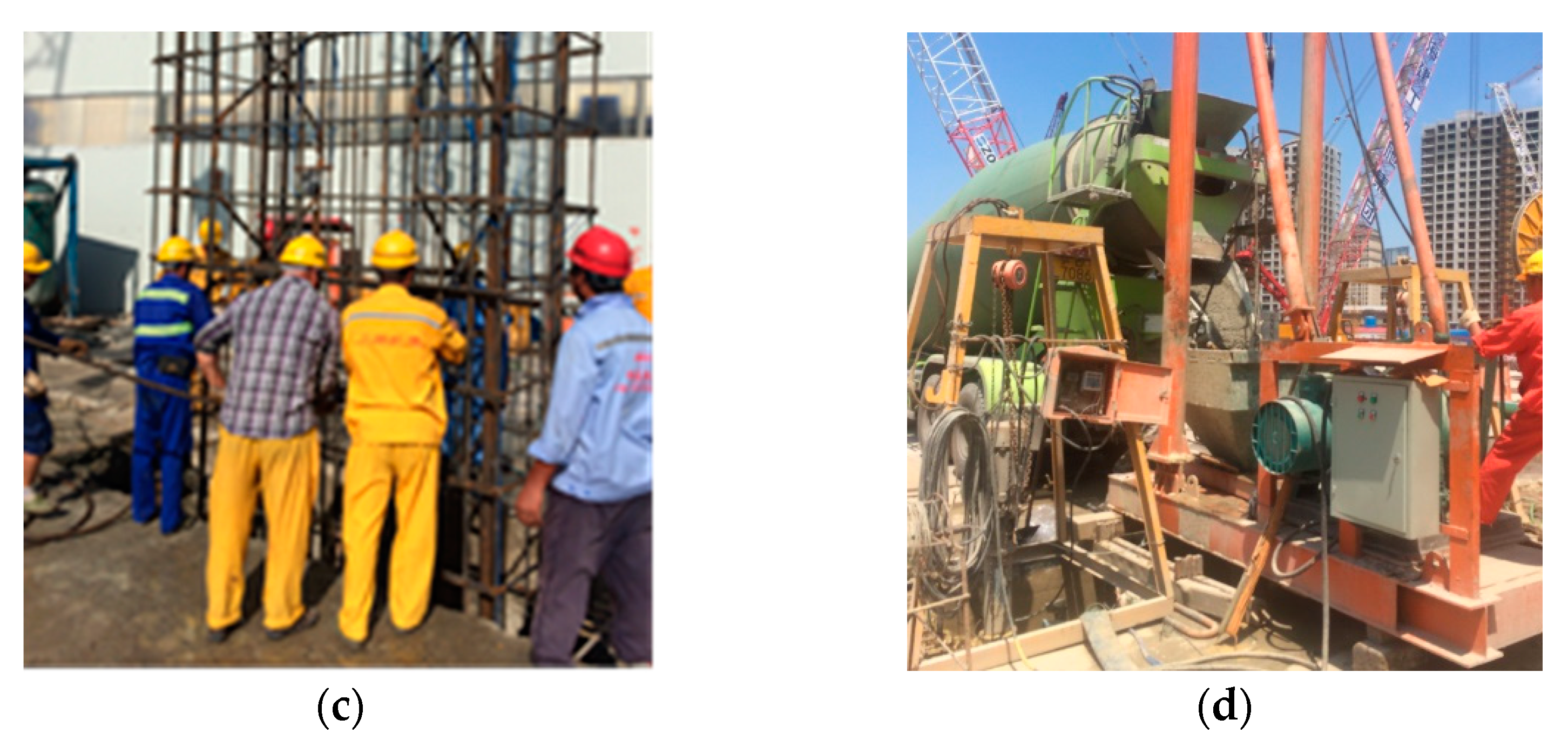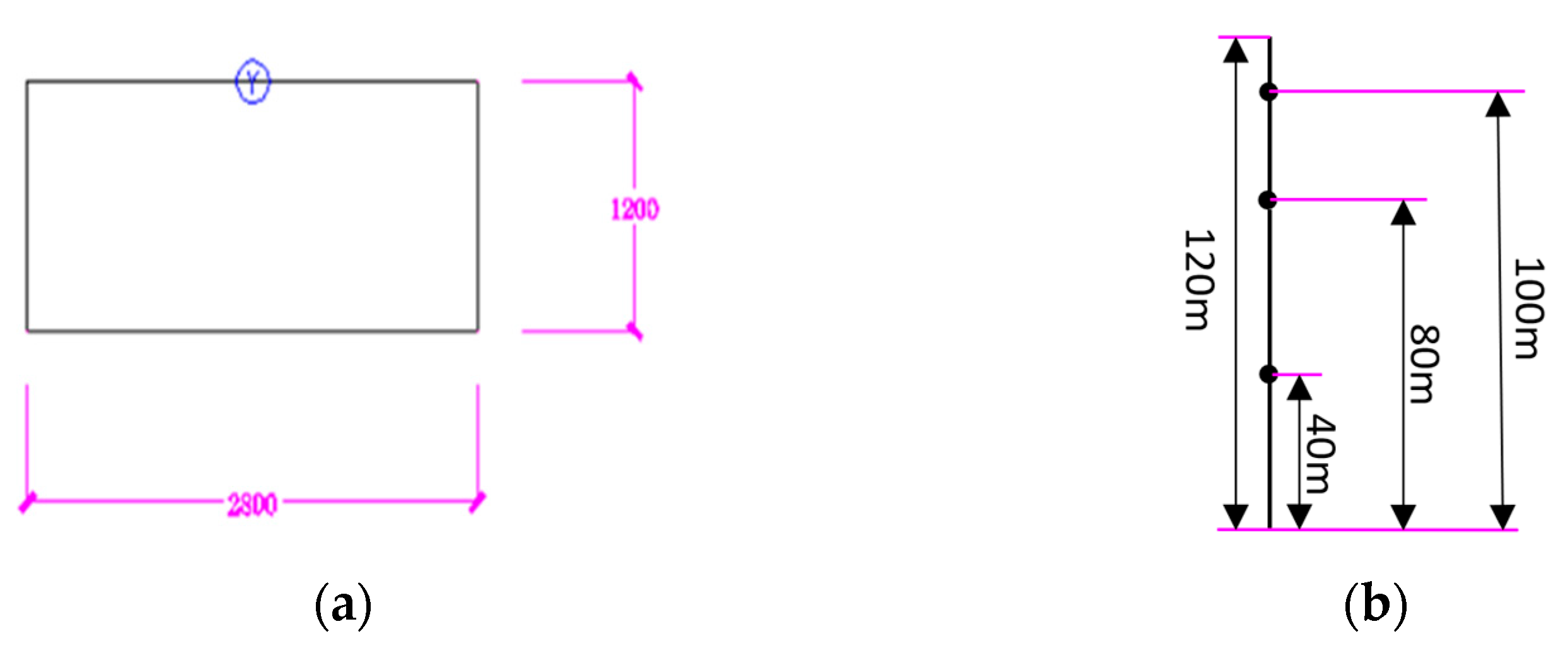Lateral Pressure of Poured Concrete: Arguments from Ultra-Deep Diaphragm Wall (120 m) Construction
Abstract
:1. Introduction
2. Materials and Methods
2.1. Materials
2.2. Underground Diaphragm Wall Filling Test
3. Results
4. Discussion
4.1. Lateral Pressure
4.2. Feature Height
4.3. Thixotropy
4.4. Casting Speed
5. Conclusions
Author Contributions
Funding
Institutional Review Board Statement
Informed Consent Statement
Data Availability Statement
Conflicts of Interest
References
- Assaad, J.J.; Khayat, K.H. Effect of casting rate and concrete temperature on formwork pressure of self-consolidating concrete. Mater. Struct. 2006, 39, 333–341. [Google Scholar] [CrossRef]
- Ghoddousi, P.; Javid, A.A.S.; Amiri, G.G.; Donyadideh, K. Predicting the Formwork Lateral Pressure of Self-consolidating Concrete Based on Experimental Thixotropy Values. Int. J. Civ. Eng. 2018, 17, 1131–1144. [Google Scholar] [CrossRef]
- Khayat, K.H.; Assaad, J.J. Effect of w/cm and High-Range Water-Reducing Admixture on Formwork Pressure and Thixotropy of Self-Consolidating Concrete. ACI Mater. J. 2006, 103, 186–193. [Google Scholar]
- Kim, J.H.; Noemi, N.; Shah, S.P. Effect of powder materials on the rheology and formwork pressure of self-consolidating concrete. Cem. Concr. Compos. 2012, 34, 746–753. [Google Scholar] [CrossRef]
- Cygan, G.; Golaszewski, J.; Drewniok, M.P. Influence of Type of Cement on the SCC Formwork Pressure During and After Casting. In IOP Conference Series: Materials Science and Engineering; IOP Publishing: Bristol, UK, 2019; Volume 471. [Google Scholar]
- Wu, W.; Li, X. Lateral Stress Characteristics of Steel Structure Wall Module Exerted by Self-Compacting Concrete. Iran. J. Sci. Technol. Trans. Civ. Eng. 2020, 44, 79–89. [Google Scholar] [CrossRef]
- Gamil, Y.; Nilimaa, J.; Emborg, M.; Cwirzen, A. Lateral Formwork Pressure for Self-Compacting Concrete—A Review of Prediction Models and Monitoring Technologies. Materials 2021, 14, 4767. [Google Scholar] [CrossRef] [PubMed]
- Proske, T.; Graubner, C.A. Formwork Pressure of Highly Workable Concrete—Experiments Focused on Setting, Vibration and Design Approach; Springer: Dordrecht, The Netherlands, 2010. [Google Scholar]
- Assaad, J.J.; Khayat, K.H. Formwork Pressure of Self-Consolidating Concrete Made with Various Binder Types and Contents. ACI Mater. J. 2005, 102, 215–223. [Google Scholar]
- Arslan, M.; Simsek, O.; Subasi, S. Effects of formwork surface materials on concrete lateral pressure. Constr. Build. Mater. 2005, 19, 319–325. [Google Scholar] [CrossRef]
- Teixeira, S.; Puente, I.; Santilli, A. Statistical model for predicting the maximum lateral pressure exerted by Self-Consolidating Concrete on vertical formwork. J. Build. Eng. 2017, 12, 77–86. [Google Scholar] [CrossRef]
- Santilli, A.; Puente, I. An empirical model to predict fresh concrete lateral pressure. Constr. Build. Mater. 2013, 47, 379–388. [Google Scholar] [CrossRef]
- DIN 18218; DIN Standard on Formwork Pressures Updated. American Concrete Institute: Farmington Hills, MI, USA, 2010; pp. 27–29.
- Billberg, P.H.; Roussel, N.; Amziane, S.; Beitzel, M.; Charitou, G.; Freund, B.; Gardner, J.N.; Grampeix, G.; Graubner, C.A.; Keller, L. Field validation of models for predicting lateral form pressure exerted by SCC. Cem. Concr. Compos. 2014, 54, 70–79. [Google Scholar] [CrossRef]
- Billberg, P. Form Pressure Generated by Self-Compacting Concrete—Influence of Thixotropy and Structural Behaviour at Rest; Royal Institute of Technology: Stockholm, Sweden, 2006. [Google Scholar]
- Khayat, K.H.; Bonen, D.; Shah, S.; Taylor, P. SCC Formwork pressure Task 1: Capturing Existing Knowledge on Formwork Pressure Exerted by SCC; National Ready-Mix Concrete Research Foundation—American Concrete Institute: Farmington Hills, MI, USA, 2007. [Google Scholar]
- Tichko, S.; Van De Maele, J.; Vanmassenhove, N.; De Schutter, G.; Vierendeels, J.; Verhoeven, R.; Troch, P. Numerical simulation of formwork pressure while pumping self-compacting concrete bottom-up. Eng. Struct. 2014, 70, 218–233. [Google Scholar] [CrossRef]
- Santilli, A.; Puente, I.; Tanco, M. A factorial design study to determine the significant parameters of fresh concrete lateral pressure and initial rate of pressure decay. Constr. Build. Mater. 2011, 25, 1946–1955. [Google Scholar] [CrossRef]
- Park, C.; Kim, J.H.; Han, S.H. A pore water pressure diffusion model to predict formwork pressure exerted by freshly mixed concrete. Cem. Concr. Compos. 2017, 75, 1–9. [Google Scholar] [CrossRef]
- Yang, Y.; Ding, X.; Liu, Y.; Deng, L.; Lv, F.; Zhao, S. Lateral Pressure Test of Vertical Joint Concrete and Formwork Optimization Design for Monolithic Precast Concrete Structure. Buildings 2022, 12, 261. [Google Scholar] [CrossRef]
- Schutter, G.D.; Feys, D.; Verhoeven, R. Ecological Profit for a Cocnrete Pipe Factory Due to Self-Compacting Concrete Technology. In Proceedings of the International Conference on Sustainable Construction Materials & Technologies, Ancona, Italy, 28–30 June 2010. [Google Scholar]
- Assaad, J.J.; Khayat, K.H.; Mesbah, H.A. Variation of formwork pressure with thixotropy of self-consolidating concrete. ACI Mater. J. 2014, 100, 29–37. [Google Scholar]
- Assaad, J.J.; Khayat, K.H. Effect of Viscosity-Enhancing Admixtures on Formwork Pressure and Thixotropy of Self-Consolidating Concrete. ACI Mater. J. 2006, 103, 280–287. [Google Scholar]
- Khayat, K.H.; Assaad, J.J. Influence of Internal Friction and Cohesion on Formwork Pressure of Self-Compacting Concrete. In Proceedings of the SCC’2005-China—1st International Symposium on Design, Performance and Use of Self-Consolidating Concrete, Hunan, China, 26–28 May 2005. [Google Scholar]







| W/B | Water | P.II 52.5 | Fly Ash | Slag | Sand | Gravel | Superplasticizer * |
|---|---|---|---|---|---|---|---|
| 0.388 | 163 | 248 | 70 | 102 | 808 | 970 | 5.88 |
| Oxidation | SiO2 | Fe2O3 | CaO | SO3 | K2O | MgO | TiO2 | Al2O3 | Na2O | LOI |
| Content% | 20.97 | 3.02 | 63.97 | 2.56 | 0.61 | 0.63 | 0.22 | 4.69 | 0.09 | 3.84 |
| No. | Start Time | End Time | Casting Time (min) | Lateral Pressure Increments at Each Point (kPa) | ||
|---|---|---|---|---|---|---|
| −100 m | −80 m | −40 m | ||||
| 1 | 8:45 | 8:58 | 13 | / | / | / |
| 2 | 9:00 | 9:15 | 15 | / | / | / |
| 3 | 9:35 | 9:53 | 18 | / | / | / |
| 4 | 10:00 | 10:18 | 18 | −3.338 | / | / |
| 5 | 10:37 | 11:00 | 23 | 109.487 | / | / |
| 6 | 11:05 | 11:30 | 25 | 80.556 | 2.8 | / |
| 7 | 11:55 | 12:13 | 18 | 28.906 | 11.7 | / |
| 8 | 12:25 | 13:10 | 45 | −75.174 | 121.9 | / |
| 9 | 13:15 | 13:30 | 15 | / | 122.1 | / |
| 10 | 13:55 | 15:20 | 85 | / | −16.6 | / |
| 11 | 15:28 | 15:43 | 15 | / | −10.3 | / |
| 12 | 15:45 | 16:00 | 15 | / | −3.9 | / |
| 13 | 16:15 | 16:40 | 25 | / | 7 | / |
| 14 | 17:00 | 17:25 | 25 | / | / | 1.784 |
| 15 | 17:43 | 18:05 | 22 | / | / | 23.706 |
| 16 | 18:30 | 18:40 | 10 | / | / | 11.342 |
| 17 | 18:45 | 19:05 | 20 | / | / | 81.678 |
| 18 | 19:30 | 19:45 | 15 | / | / | −7.442 |
| 19 | 21:20 | 21:43 | 23 | / | / | 14.918 |
| 20 | 21:45 | 22:10 | 25 | / | / | −30.423 |
| 21 | 22:37 | 22:52 | 15 | / | / | / |
| 22 | 00:55 | 01:25 | 30 | / | / | / |
| No. | Casting Time (min) | Casting Interval (min) | Casting Speed (m/h) |
|---|---|---|---|
| 1 | 13 | 24.732 | |
| 2 | 15 | 2 | 21.42 |
| 3 | 18 | 20 | 17.856 |
| 4 | 18 | 7 | 17.856 |
| 5 | 23 | 19 | 13.968 |
| 6 | 25 | 5 | 12.852 |
| 7 | 18 | 25 | 17.856 |
| 8 | 45 | 12 | 7.128 |
| 9 | 15 | 5 | 21.42 |
| 10 | 85 | 25 | 3.78 |
| 11 | 15 | 8 | 21.42 |
| 12 | 15 | 2 | 21.42 |
| 13 | 25 | 5 | 12.852 |
| 14 | 25 | 20 | 12.852 |
| 15 | 22 | 18 | 14.616 |
| 16 | 10 | 25 | 32.148 |
| 17 | 20 | 5 | 16.056 |
| 18 | 15 | 25 | 21.42 |
| 19 | 23 | 95 | 13.968 |
| 20 | 25 | 2 | 12.852 |
| 21 | 15 | 27 | 21.42 |
| 22 | 30 | 63 | 10.728 |
| Elevation (m) | Initial Slurry Pressure | Maximum Lateral Pressure | ||
|---|---|---|---|---|
| Hydrostatic Pressure * | γch ** | Measured Value | ||
| −40 | 0.555 | 0.4 | 1 | 0.939 |
| −80 | 0.939 | 0.8 | 2 | 1.311 |
| −100 | 1.312 | 1.0 | 2.5 | 1.639 |
Publisher’s Note: MDPI stays neutral with regard to jurisdictional claims in published maps and institutional affiliations. |
© 2022 by the authors. Licensee MDPI, Basel, Switzerland. This article is an open access article distributed under the terms and conditions of the Creative Commons Attribution (CC BY) license (https://creativecommons.org/licenses/by/4.0/).
Share and Cite
Jiang, W.; Zheng, X.; Huang, Z. Lateral Pressure of Poured Concrete: Arguments from Ultra-Deep Diaphragm Wall (120 m) Construction. Appl. Sci. 2022, 12, 8800. https://doi.org/10.3390/app12178800
Jiang W, Zheng X, Huang Z. Lateral Pressure of Poured Concrete: Arguments from Ultra-Deep Diaphragm Wall (120 m) Construction. Applied Sciences. 2022; 12(17):8800. https://doi.org/10.3390/app12178800
Chicago/Turabian StyleJiang, Wei, Xinyue Zheng, and Zhishan Huang. 2022. "Lateral Pressure of Poured Concrete: Arguments from Ultra-Deep Diaphragm Wall (120 m) Construction" Applied Sciences 12, no. 17: 8800. https://doi.org/10.3390/app12178800





